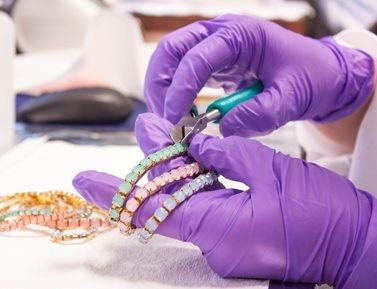Toxics monitoring in consumer products
We design studies to test for toxic chemicals in consumer products. These chemicals can build up over time and harm people and the environment. For this reason, Washington passed several laws to regulate chemicals in products.
Everyday sources of toxic chemicals
Many products people use daily contain and release low doses of toxic chemicals. That’s where we come in. We test products to uncover hidden toxics and help keep these harmful chemicals out of our homes and the environment.
Items such as personal care products we apply to our bodies, clothes we wear, pots and pans we cook with, toys our children play with, and flooring and furniture we surround ourselves with might contain harmful chemicals. We are exposed to toxic chemicals when these products release chemicals into the air we breathe, things we eat and drink, and surfaces we touch. Finally, when products are disposed of improperly, their chemicals escape into the soil, air, or water over time. Some products are recycled into new products containing the same toxic chemicals. That’s why our scientists monitor consumer products for harmful chemicals.

Examples of chemicals our scientists test for and products that contain these chemicals.

Product studies scientist taking samples from a bracelet to test for cadmium and other toxic chemicals.
What we do
Scientists and chemists from our Environmental Assessment Program and Manchester Environmental Laboratory work together to design studies, develop methods, and test for toxic chemicals in a variety of consumer products to collect information on which chemicals are present in certain products. We use this information to make sure manufacturers comply with Washington’s laws.
Collecting consumer product samples is very different from collecting environmental samples like water or soil. Our collection sites are in stores, shopping centers, and online instead of in lakes, rivers and forests. For every product type, there are many options to choose from, and certain products may be available in one store but not another.
Testing process
One consumer product can be made up of several material types — metal, plastic, fabrics, glass, liquids, creams, and powders — and each requires a different testing approach. All product samples need to be in liquid form for lab testing. Some materials need little preparation, while others, like solid plastics, need more time to be reduced in size using specialized instruments that can turn a solid sample into a fine powder and then a liquid. Fine powder samples allow for more accurate testing.

Cryomilling process from whole sample to powder. Our scientists use a cryomill, which is an instrument that uses liquid nitrogen and friction to turn a solid sample into a fine powder.
Regardless of the testing technique, we always follow the best quality assurance practices to produce accurate and defensible data.
As leaders in understanding everyday sources of toxics in consumer products, we are continually growing and responding to industry shifts by advancing our regulatory science.
Reports and data
Our findings
Our reports and project plans explain the work done by product studies scientists at Ecology. Study designs are published on our website as Quality Assurance Project Plans (QAPPs). QAPPs outline study objectives and the procedures the project will follow to make sure samples, data, and reports meet data quality and project objectives.
The published reports detail our findings. The studies help us assess compliance with Washington’s current chemical regulations and determine future efforts to reduce and eliminate toxic chemicals. Product follow-up studies provide information about changes in chemicals used in certain products, and method development studies are performed to expand our testing capabilities.
Our data
Our Consumer Products Database contains consumer product data collected from each study and provides a snapshot of toxic chemical present in everyday products at the time of testing.
While the database tells you what toxic chemicals are present in the consumer products, it can't tell you which individual products are safe or harmful to human health. Exposure risk is affected by other factors we do not test for, such as how the products are used and the duration of use.
Related links
Contact information
Amy Salamone
Lead Product Studies Scientist, Product Replacement Study Lead
amy.salamone@ecy.wa.gov
564-669-1760
Karna Holquist
Product Studies Chemist, Method Development and Special Projects
karna.holquist@ecy.wa.gov
564- 669-4189
Sara Sekerak
Chemist, Product Studies Unit Supervisor
sara.sekerak@ecy.wa.gov
360-480-9501

